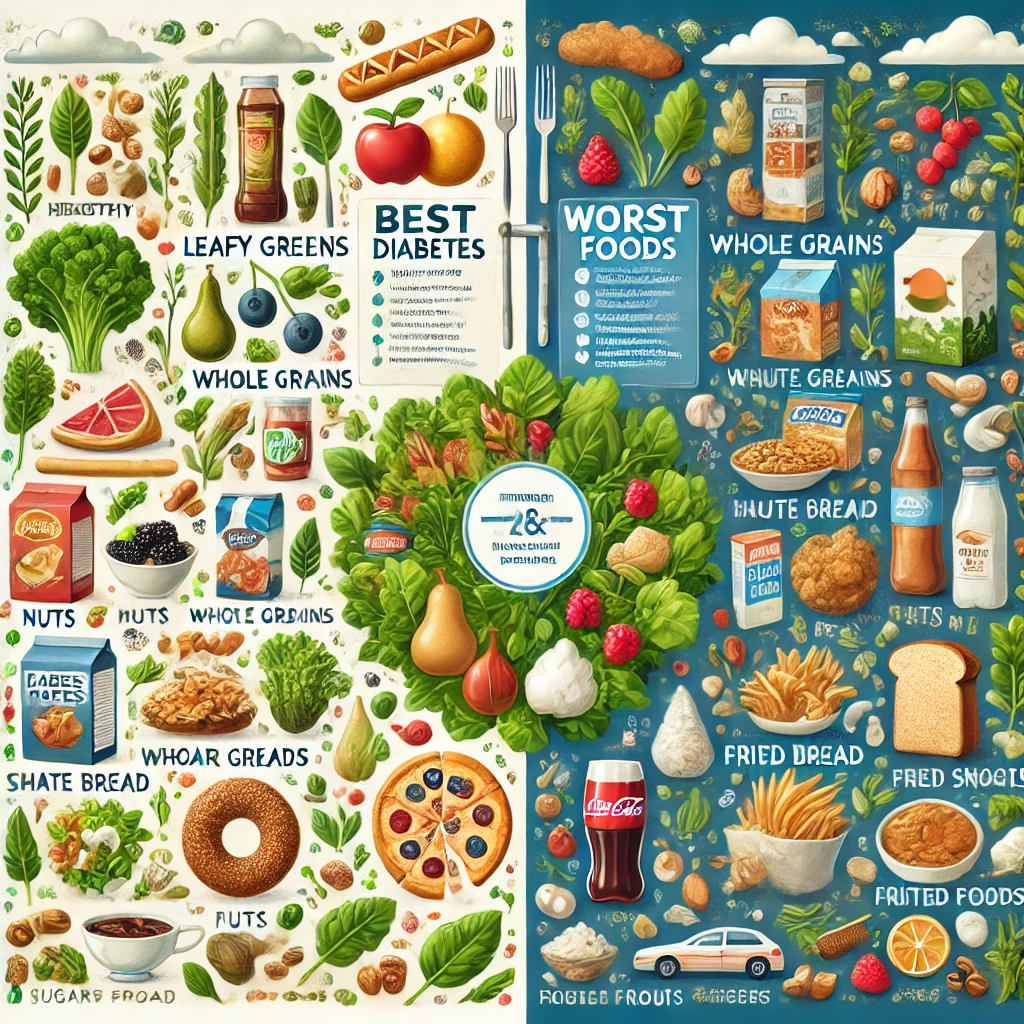Best and Worst Foods for Diabetes: A Complete Food List
Introduction
Managing diabetes effectively starts with the right diet. The foods you eat play a crucial role in controlling blood sugar levels, reducing complications, and improving overall health. But which foods should you prioritize, and which should you avoid?
In this guide, we will explore the best and worst foods for diabetes, providing you with a comprehensive food list to help you make healthier choices. Whether you’re newly diagnosed or looking to fine-tune your diet, this article will serve as a valuable resource.
Best Foods for Diabetes Management
A well-balanced diabetes diet plan includes nutrient-dense foods that help stabilize blood sugar levels, improve insulin sensitivity, and promote overall health. Here are the best food choices for diabetics:
1. Non-Starchy Vegetables
Non-starchy vegetables are low in carbohydrates and rich in fiber, vitamins, and minerals, making them excellent for blood sugar control.
✅ Examples:
- Leafy greens (spinach, kale, lettuce)
- Broccoli
- Cauliflower
- Bell peppers
- Cucumbers
- Zucchini
⏩ Why They’re Good: They have a low glycemic index (GI) and help maintain stable blood sugar levels.
2. High-Fiber Foods
Fiber slows down sugar absorption, preventing blood sugar spikes. Aim for at least 25–30 grams of fiber per day.
✅ Examples:
- Beans and lentils
- Chia seeds and flaxseeds
- Quinoa
- Whole oats
- Berries (blueberries, raspberries, strawberries)
⏩ Why They’re Good: Fiber-rich foods support better blood sugar control and improve digestion.
3. Lean Proteins
Proteins help stabilize blood sugar by slowing down digestion and preventing sugar spikes.
✅ Examples:
- Chicken breast
- Turkey
- Fish (salmon, tuna, sardines)
- Eggs
- Tofu and tempeh
- Greek yogurt
⏩ Why They’re Good: Lean proteins help with muscle maintenance and reduce cravings for unhealthy snacks.
4. Healthy Fats
Healthy fats improve insulin function and reduce inflammation, which is beneficial for people with diabetes.
✅ Examples:
- Avocados
- Nuts (almonds, walnuts, cashews)
- Olive oil
- Fatty fish
- Seeds (pumpkin, sunflower, flaxseeds)
⏩ Why They’re Good: They support heart health and help maintain stable blood sugar levels.
Worst Foods for Diabetics
Some foods can spike blood sugar levels and lead to insulin resistance. Avoid or limit these foods to maintain better diabetes control.
1. Sugary Beverages
🚫 Examples:
- Regular soda
- Fruit juices
- Sweetened coffee drinks
- Energy drinks
⏩ Why They’re Bad: They contain high amounts of sugar, leading to rapid blood sugar spikes.
2. Refined Carbohydrates
🚫 Examples:
- White bread
- White rice
- Pasta
- Pastries and cakes
⏩ Why They’re Bad: These foods have a high glycemic index, causing quick spikes and crashes in blood sugar levels.
3. Processed and Fried Foods
🚫 Examples:
- French fries
- Fried chicken
- Potato chips
- Fast food burgers
⏩ Why They’re Bad: They are high in unhealthy fats and refined carbs, leading to weight gain and insulin resistance.
Glycemic Index Foods for Diabetics
The glycemic index (GI) ranks foods based on how they affect blood sugar levels.
- Low GI (Best for diabetics): Vegetables, whole grains, nuts, beans
- Medium GI: Brown rice, sweet potatoes, whole wheat bread
- High GI (Avoid): White bread, processed cereals, candy
Tip: Stick to low-GI foods for better blood sugar control!
Carbohydrate Counting for Diabetes
Carbohydrates have the biggest impact on blood sugar. Carb counting helps you manage your intake effectively.
- General guideline:
- 45–60g of carbs per meal
- 15–20g of carbs per snack
- Examples of carb counts:
- 1 slice of whole-grain bread = 15g carbs
- ½ cup cooked quinoa = 20g carbs
- 1 small apple = 15g carbs
Tip: Pair carbs with protein and fiber to prevent sugar spikes!
FAQs
What Is the Best Food for Lowering Blood Sugar?
Leafy greens, high-fiber foods, lean proteins, and healthy fats help stabilize blood sugar levels.
Can Diabetics Eat Rice?
Yes, but choose brown rice or quinoa over white rice and eat in moderation.
What Snacks Are Good for Diabetics?
Healthy snack options include nuts, Greek yogurt, hummus with veggies, and boiled eggs.
How Much Sugar Can a Diabetic Eat?
Diabetics should limit added sugars to no more than 25g per day (around 6 teaspoons).
Are Artificial Sweeteners Safe for Diabetics?
Some artificial sweeteners like stevia and erythritol are safe but avoid excessive use of others like aspartame.
Conclusion
Making the right food choices is essential for effective diabetes management. By incorporating diabetes-friendly foods and avoiding those that raise blood sugar levels, you can improve your overall health and reduce complications.
📩 Subscribe to our newsletter for more expert health tips and recipes!
References:
- American Diabetes Association: www.diabetes.org
- Harvard T.H. Chan School of Public Health: www.hsph.harvard.edu
- Mayo Clinic: www.mayoclinic.org
